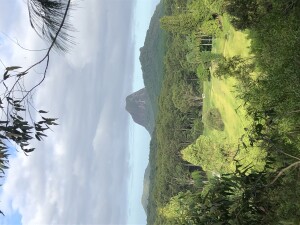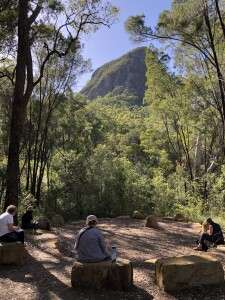 On our recent Glass House Mountains retreat we had plenty of time to contemplate the notion of writing the mountain.
On our recent Glass House Mountains retreat we had plenty of time to contemplate the notion of writing the mountain.
At Namgyalgar Retreat Centre on the Sunshine Coast of South East Queensland, we were surrounded on all sides by the cluster of thirteen dramatic landforms that rise up from the coastal plain, the result of volcanic activity that took place 26 – 27 million years ago. In 1770 Captain Cook named them after the glasshouse furnaces of Yorkshire, but they each have their own Indigenous name and have played an important role in the life and culture of Jinibara and Gubbi Gubbi (Kabi Kabi) traditional owners for many thousands of years.
From the top of our land we could see Mount Coonowrin, Mount Beerwah and Mount Tibrogargan and just a short walk or drive to the nearby Look Out, we could see them all in an extraordinary 360 vista. And when you drive or walk around the area, a moveable feast of different land forms rise up to greet you. Prior to the retreat as I went about shopping for supplies, I was able to observe them in all their different moods, colours, weather — close up and distant. And I kept coming back to this thought— the one thing the mountain teaches us better than anything, is the meaning of presence.
Hence, on our retreat we beavered away, working at bringing presence into our writing: presence of place, presence of character and looking to the mountain as a metaphor for achieving our end goal, the completion of our drafts.
In our workshop on the presence of landscape, from her article on The Most Powerful Landscapes in Fiction, I quoted this advice from the acclaimed historical fiction author Hannah Kent (Burial Rites, The Good People, Devotion).
‘The skill in writing landscape is to capture it in concise, startling references, well placed within the narrative, that accumulate to create a pervading presence.’
We understood this well as we walked the track around the base of Mt Tibrogargan, witnessing its many moods and marvelling at the differing array of flora and fauna that abounds in its shadow. Near the end of our walk we stopped at a circle of sandstone rocks arranged near the foot of the mountain and wrote observances, lists, thoughts, or a scene from our book. In the exquisite stillness of the moment it was hard to know if we were writing the mountain, or if the mountain was writing us. But it didn’t matter, for now we were part of the presence too.

Thanks to our hosts, Ian and Sarita at Namgyalgar, who looked after us so well!
See more photos from our Easter retreat on Flickr here.
Read some pieces by our Easter writers on Medium here
The Legend of The Glass House Mountains
‘The legend tells of Tibrogargan noticing that the sea was rising and calling out to his son Coonowrin to help his pregnant mother gather the young children together so that the family could flee from the rising sea. Coonowrin ran away in fear and Tibrogargan, incensed by his son’s cowardice, followed and hit him so hard with a club that his neck was dislocated. When the seas retreated the family returned to the plains. Conowrin, teased about his crooked neck and ashamed of his behaviour, went to Tibrogargan and asked for forgiveness but the father just wept with shame. Conowrin then approached his brothers and sisters to ask forgiveness but they too could only weep with shame, thus explaining the area’s many small streams. Tibrogargan then called Conowrin and asked why he had failed to help Beerwah. He explained that he felt she was big enough to look after herself, though he did not know she was pregnant. Tibrogargan then turned his back on his son and still gazes out to sea today, refusing to look at his son who forever hangs his crooked neck and cries. Beerwah, the mother, is still pregnant, as it takes time to give birth to a mountain.’
What some of our writers said:
Everything was a wonderful experience: the workshops, ably guided by Jan, the wonderful group of fellow writers who were inspiring, and the lovely location which was so peaceful. There was a warm sense of being looked after while we explored the craft of writing and discovered our best writing selves. Catherine Briggs, read her writing on Medium here.
My overall experience was one of being in a supportive and inspiring group led skilfully by Jan, who has honed her skills using various methods and exercises, to encourage participants in pulling out the best of the writing that’s in them. She also knows how to be extremely funny when tedium or exhaustion sets in, to lighten the mood. Hwa Rogers, read her writing on Medium here.
I attended the first Writers Journey Writer’s Retreat at Namgyalgar at the Glasshouse Mountains in Queensland. I had been suffering terrible writers’ block working on my new novel although the research had been going well. Jan’s workshops and the feedback and readings helped me “unblock” and I was writing again! A beautiful, peaceful place where you are left to write – the whole point of being there! Diana Plater, read her writing on Medium here.
Coming Up
Draft Busters Online sign up for a monthly module here.
